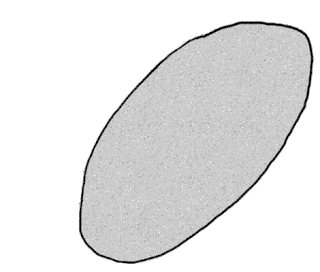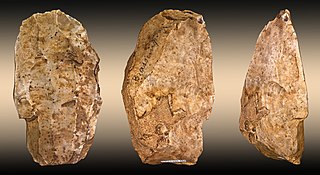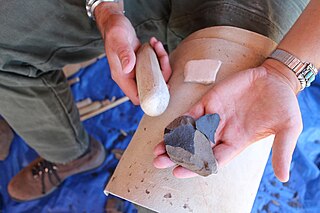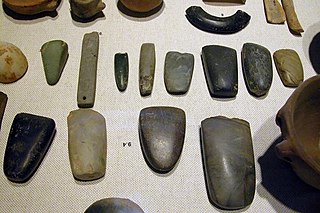Related Research Articles

In archaeology, a hammerstone is a hard cobble used to strike off lithic flakes from a lump of tool stone during the process of lithic reduction. The hammerstone is a rather universal stone tool which appeared early in most regions of the world including Europe, India and North America. This technology was of major importance to prehistoric cultures before the age of metalworking.

In archaeology, in particular of the Stone Age, lithic reduction is the process of fashioning stones or rocks from their natural state into tools or weapons by removing some parts. It has been intensely studied and many archaeological industries are identified almost entirely by the lithic analysis of the precise style of their tools and the chaîne opératoire of the reduction techniques they used.

In archaeology, a lithic flake is a "portion of rock removed from an objective piece by percussion or pressure," and may also be referred to as simply a flake, or collectively as debitage. The objective piece, or the rock being reduced by the removal of flakes, is known as a core. Once the proper tool stone has been selected, a percussor or pressure flaker is used to direct a sharp blow, or apply sufficient force, respectively, to the surface of the stone, often on the edge of the piece. The energy of this blow propagates through the material, often producing a Hertzian cone of force which causes the rock to fracture in a controllable fashion. Since cores are often struck on an edge with a suitable angle (<90°) for flake propagation, the result is that only a portion of the Hertzian cone is created. The process continues as the flintknapper detaches the desired number of flakes from the core, which is marked with the negative scars of these removals. The surface area of the core which received the blows necessary for detaching the flakes is referred to as the striking platform.
In lithic analysis, a subdivision of archaeology, a bulb of applied force is a defining characteristic of a lithic flake. Bulb of applied force was first correctly described by Sir John Evans, the cofounder of prehistoric archeology. However, bulb of percussion was coined scientifically by W.J. Sollas. When a flake is detached from its parent core, a portion of the Hertzian cone of force caused by the detachment blow is detached with it, leaving a distinctive bulb on the flake and a corresponding flake scar on the core. In the case of a unidirectional core, the bulb of applied force is produced by an initiated crack formed at the point of contact, which begins producing the Hertzian cone. The outward pressure increases causing the crack to curve away from the core and the bulb formation. The bulb of applied force forms below the striking platform as a slight bulge. If the flake is completely crushed the bulb will not be visible. Bulbs of applied force may be distinctive, moderate, or diffuse, depending upon the force of the blow used to detach the flake, and upon the type of material used as a fabricator. The bulb of applied force can indicate the mass or density of the tool used in the application of the force. The bulb may also be an indication of the angle of the force. This information is helpful to archaeologists in understanding and recreating the process of flintknapping. Generally, the harder the material used as a fabricator, the more distinctive the bulb of applied force. Soft hammer percussion has a low diffuse bulb while hard hammer percussion usually leaves a more distinct and noticeable bulb of applied force. Pressure flake also allowed for diffuse bulbs. The bulb of percussion of a flake or blade is convex and the core has a corresponding concave bulb. The concave bulb on the core is known as the negative bulb of percussion. Bulbs of applied force are not usually present if the flake has been struck off naturally. This allows archaeologists to identify and distinguish natural breakage from human artistry. The three main bulb types are flat or nondescript, normal, and pronounced. A flat or nondescript bulb is poorly defined and does not rise up on the ventral surface. A normal bulb on the ventral side has average height and well-defined. A pronounced bulb rises up on ventral side and is very large.

In archaeology, a lithic core is a distinctive artifact that results from the practice of lithic reduction. In this sense, a core is the scarred nucleus resulting from the detachment of one or more flakes from a lump of source material or tool stone, usually by using a hard hammer precursor such as a hammerstone. The core is marked with the positive scars of these flakes. The surface area of the core which received the blows necessary for detaching the flakes is referred to as the striking platform. The core may be discarded or shaped further into a core tool, such as can be seen in some types of handaxe.
In archaeology, a tool stone is a type of stone that is used to manufacture stone tools, or tools that use stone as raw material.
In the archaeological study of lithic reduction, the striking platform is the surface on the proximal portion of a lithic flake on which the detachment blow falls; this may be natural or prepared. Types of striking platforms include:
A stone tool is, in the most general sense, any tool made either partially or entirely out of stone. Although stone tool-dependent societies and cultures still exist today, most stone tools are associated with prehistoric cultures that have become extinct. Archaeologists often study such prehistoric societies, and refer to the study of stone tools as lithic analysis. Ethnoarchaeology has been a valuable research field in order to further the understanding and cultural implications of stone tool use and manufacture.

Knapping is the shaping of flint, chert, obsidian, or other conchoidal fracturing stone through the process of lithic reduction to manufacture stone tools, strikers for flintlock firearms, or to produce flat-faced stones for building or facing walls, and flushwork decoration. The original Germanic term knopp meant to strike, shape, or work, so it could theoretically have referred equally well to making statues or dice. Modern usage is more specific, referring almost exclusively to the hand-tool pressure-flaking process pictured. It is distinguished from the more general verb "chip" and is different from "carve", and "cleave".

In archaeology, ground stone is a category of stone tool formed by the grinding of a coarse-grained tool stone, either purposely or incidentally. Ground stone tools are usually made of basalt, rhyolite, granite, or other cryptocrystalline and igneous stones whose coarse structure makes them ideal for grinding other materials, including plants and other stones.
In archaeology, lithic analysis is the analysis of stone tools and other chipped stone artifacts using basic scientific techniques. At its most basic level, lithic analyses involve an analysis of the artifact's morphology, the measurement of various physical attributes, and examining other visible features.

A conchoidal fracture is a break or fracture of a brittle material that does not follow any natural planes of separation. Mindat.org defines conchoidal fracture as follows: "a fracture with smooth, curved surfaces, typically slightly concave, showing concentric undulations resembling the lines of growth of a shell". Materials that break in this way include quartz, chert, flint, quartzite, jasper, and other fine-grained or amorphous materials with a composition of pure silica, such as obsidian and window glass, as well as a few metals, such as solid gallium.

The Oldowan was a widespread stone tool archaeological industry (style) in prehistory. These early tools were simple, usually made with one or a few flakes chipped off with another stone. Oldowan tools were used during the Lower Paleolithic period, 2.9 million years ago up until at least 1.7 million years ago (Ma), by ancient Hominins across much of Africa. This technological industry was followed by the more sophisticated Acheulean industry.

A Hertzian cone is the cone produced when an object passes through a solid, such as a bullet through glass. More technically, it is a cone of force that propagates through a brittle, amorphous, or cryptocrystalline solid material from a point of impact. This force eventually removes a full or partial cone in the material. This is the physical principle that explains the form and characteristics of the flakes removed from a core of tool stone during the process of lithic reduction.

In archaeology, a blade is a type of stone tool created by striking a long narrow flake from a stone core. This process of reducing the stone and producing the blades is called lithic reduction. Archaeologists use this process of flintknapping to analyze blades and observe their technological uses for historical purposes.

The Levallois technique is a name given by archaeologists to a distinctive type of stone knapping developed around 250,000 to 300,000 years ago during the Middle Palaeolithic period. It is part of the Mousterian stone tool industry, and was used by the Neanderthals in Europe and by modern humans in other regions such as the Levant.
Retouch is the act of producing scars on a stone flake after the ventral surface has been created. It can be done to the edge of an implement in order to make it into a functional tool, or to reshape a used tool. Retouch can be a strategy to reuse an existing lithic artifact and enable people to transform one tool into another tool. Depending on the form of classification that one uses, it may be argued that retouch can also be conducted on a core-tool, if such a category exists, such as a hand-axe.

In archaeology, a cleaver is a type of biface stone tool of the Lower Palaeolithic.

In archaeology, a flake tool is a type of stone tool that was used during the Stone Age that was created by striking a flake from a prepared stone core. People during prehistoric times often preferred these flake tools as compared to other tools because these tools were often easily made, could be made to be extremely sharp & could easily be repaired. Flake tools could be sharpened by retouch to create scrapers or burins. These tools were either made by flaking off small particles of flint or by breaking off a large piece and using that as a tool itself. These tools were able to be made by this "chipping" away effect due to the natural characteristic of stone. Stone is able to break apart when struck near the edge. Flake tools are created through flint knapping, a process of producing stone tools using lithic reduction.

In archaeology, debitage is all the material produced during the process of lithic reduction – the production of stone tools and weapons by knapping stone. This assemblage may include the different kinds of lithic flakes and lithic blades, but most often refers to the shatter and production debris, and production rejects.
References
- ↑ Harmand, Sonia; Lewis, Jason E.; Feibel, Craig S.; Lepre, Christopher J.; Prat, Sandrine; Lenoble, Arnaud; Boës, Xavier; Quinn, Rhonda L.; Brenet, Michel; Arroyo, Adrian; Taylor, Nicholas; Clément, Sophie; Daver, Guillaume; Brugal, Jean-Philip; Leakey, Louise (2015). "3.3-million-year-old stone tools from Lomekwi 3, West Turkana, Kenya". Nature. 521 (7552): 310–315. Bibcode:2015Natur.521..310H. doi:10.1038/nature14464. ISSN 1476-4687. PMID 25993961.
- 1 2 Weedman, Kathryn (2006). "An ethnoarchaeological study of hafting and stone tool diversity among the Gamo of Ethiopia". Journal of Archaeological Method and Theory. 13 (3): 198–238. doi:10.1007/s10816-006-9010-4. JSTOR 20177539.
- ↑ Torrence, Robin (1989). Time, Energy, and Stone Tools. Cambridge: Cambridge University Press. pp. 57–66.
- ↑ Mackay, Alex; Marwick, Ben (2011). "Costs and benefits in technological decision making under variable conditions: examples from the late Pleistocene in southern Africa". Keeping your Edge: Recent Approaches to the Organisation of Stone Artefact Technology.
- ↑ Driscoll, Killian (2010). Understanding quartz technology in early prehistoric Ireland (Thesis). University College Dublin.
- ↑ Dibble, Harold; Whittaker, John (1981). "New Experimental Evidence on the Relation Between Percussion Flaking and Flake Variation" (PDF). Journal of Archaeological Science. 8 (3): 283–296. Bibcode:1981JArSc...8..283D. doi:10.1016/0305-4403(81)90004-2 . Retrieved 27 July 2017.